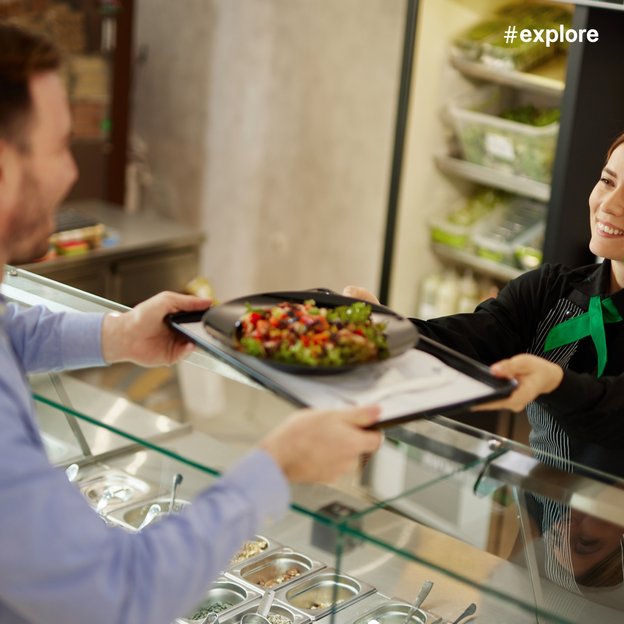Nutrition
Good food, fresh from the canteen
What the ideal company restaurant looks like.

Nutrition
What the ideal company restaurant looks like.

25 September 2025
We all have to eat. But not all foods are good for us. And the way they are produced, packaged and transported is all too often bad for the environment. The same is true of the food provided in canteens and refectories. Marieke Thomas, director of TÜV NORD’s company restaurants in Hamburg, Hanover and Essen, explains how they go about making the food they offer the employees as healthy and sustainable as possible.
#explore: Ms. Thomas, what are the key levers for making company restaurants as sustainable as possible?
Marieke Thomas: For our dishes, we focus on seasonal fruit and vegetables from regionally based suppliers. Our meat comes from regional slaughterhouses, and we only serve certified fish. Balanced nutrition is the be-all and end-all: there are three dishes every day, one of which is vegetarian or vegan, plus the side dish counter and the salad bar. There’s something for everyone. To avoid plastic and offer healthier food, we avoid convenience products as far as we can. In the kitchens, we use resource-saving and energy-efficient appliances. Our dishwasher, for example, uses the residual heat from the rinse water and the ambient air to heat up the water for the next wash cycle. This means that the waste heat isn’t lost, which has enabled us to reduce water consumption and heating energy costs by more than a third compared to older appliances.
How do you plan portion sizes to ensure that as many people as possible are fed while also minimising food wastage?
Marieke Thomas: The canteen managers at our sites in Essen, Hamburg and Hanover have many years of experience in this area and are correspondingly skilled at estimating how much food is needed. Interestingly, as far as how much the employees eat is concerned, there are definitely differences between the sites. There’s ample evidence that we’re getting better and better at planning portion sizes. For example, the last time we measured our waste, we saw that leftovers had decreased a lot compared to 2020 and that relatively little food was being left on people’s plates.
What concrete measures have you already implemented to reduce the amount of waste and to recycle food?
Marieke Thomas: Because we hardly use any convenience products anymore, we’re generating significantly less plastic waste. Another important factor in reducing waste has been our use of reusable containers made by Vytal, which we introduced in 2021 and use for things like cereals, bowls and salad. We collect vegetable scraps and other wet waste plus old cooking oil, which get picked up by ReFood and then processed into biogas or fertiliser. Leftover food is offered on the side dish counter the next day or reused in our “tip of the day” on Fridays. This is usually a casserole, which is a real hit! We always see plenty of long faces when people arrive to find that the casserole has yet again gone by twelve-fifteen!
Are you also actively trying to generate awareness of healthy and sustainable nutrition?
Marieke Thomas: We don’t tell the staff what they should eat, of course. No, our aim instead is to make people think and offer them suggestions, for example by putting on week-long campaigns that focus on different aspects of nutrition. In September, for example, we did a campaign week with an emphasis on cardiovascular health, during which we offered snacks that were particularly good for the heart and the circulation, among other things.
Are employees changing their dietary habits? Are people eating more vegetables, for instance?
Marieke Thomas: Sustainability and high-quality food are important to most of our workforce, as a survey showed last year. In general, we’ve seen that awareness is growing. Vegetarian or vegan bowls with homemade hummus are in great demand, especially among the younger generation. And our “Go Green” range, which exclusively serves seasonal and regional food and certified fish, is in such demand that we’re now offering it three times a week instead of twice. Next year, 70 percent of what we offer will be meatless.
What other measures do you want to introduce in the future?
Marieke Thomas: Among other things, we’re thinking about food saver campaigns for food that can’t be reused the next day – leftover pizzas, for example, which employees could then take home for half price. But we’ve first got to sort out any possible liability issues. We’re also currently looking at whether it might makes sense to buy raised beds for our sites to allow us to plant herbs and salads on site and eliminate the need for transport for these foods.
This is an article from #explore. #explore is a digital journey of discovery into a world that is rapidly changing. Increasing connectivity, innovative technologies, and all-encompassing digitalization are creating new things and turning the familiar upside down. However, this also brings dangers and risks: #explore shows a safe path through the connected world.